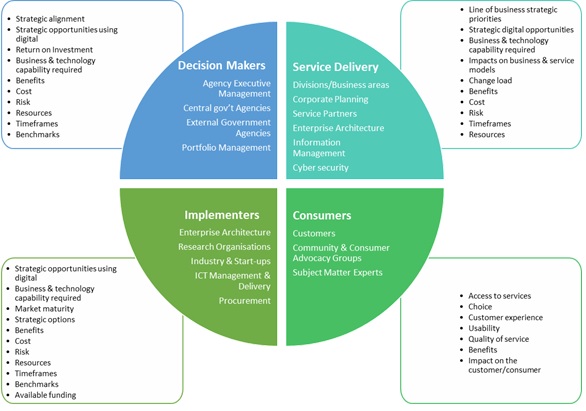Sponsorship is different from championing the planning engagement although a sponsor can also be a champion. A sponsor is required to give the process legitimacy. Champions provide the drive and energy to see the process through.
The Chief Executive Officer (CEO), Chief Customer and Digital Officer, Information Steering Committee (or equivalent) or a senior executive representing the business may initiate digital and ICT strategic planning, and the success of the planning engagement often depends on the level of sponsorship and championship of the initiative within the agency.
Traditionally, the role of the sponsor is assigned to the Chief Information Officer (CIO). This may not be optimal in all circumstances. As digital becomes more integral to business and service delivery, digital planning activities are more likely to be perceived as legitimate if sponsored by executive leadership such as the CEO. If the CEO is selected as the sponsor, the CIO could and should continue to champion the activities.
Think about the strong executive leaders in your organisation. In what circumstances would it be appropriate for them to be the sponsor for a digital or ICT strategic planning engagement? For example, they may be willing to sponsor an overarching digital vision or strategy that takes into account service transformation across the organisation.
Criteria for evaluating sponsors
An effective sponsor will demonstrate the following characteristics.
Compelling communication skills
A sponsor must have a clear understanding of the agency’s vision and objectives and how the planning engagement will support the achievement of those objectives. They must also be able to articulate to the agency why digital or ICT planning is important, the risks associated with not acting, and encourage engagement and participation in the planning activities.
Leadership style
A sponsor must be able to see the big picture, but also have the skills to identify specific areas that may pose a challenge or require additional focus. The effective sponsor will keep the planning team motivated and moving forward by ensuring the right people are identified to solve problems that may arise.
Trust
Trust is a set of attributes that include listening, sharing and challenging others to achieve goals. The executive sponsor should be highly respected by the team, as well as by colleagues and others associated with the planning engagement. The sponsor should command attention of the planning team, direct appropriate action, influence and communicate broadly across the agency, and be trusted by both internal and external stakeholders.
Accountability
The sponsor should be committed and willing to take ownership of the planning engagement. They are on the look-out for any barriers or impediments that need to be progressed or addressed. The executive sponsor should define and communicate the benefits of the planning engagement and establish a culture of accountability.
Change advocate
The sponsor should have a strong understanding of the business of the agency and the concerns of the staff and customers accessing the services of the agency. They will be a strong advocate for change. The sponsor should be influential, a respected negotiator, and have a track record of getting things done.



